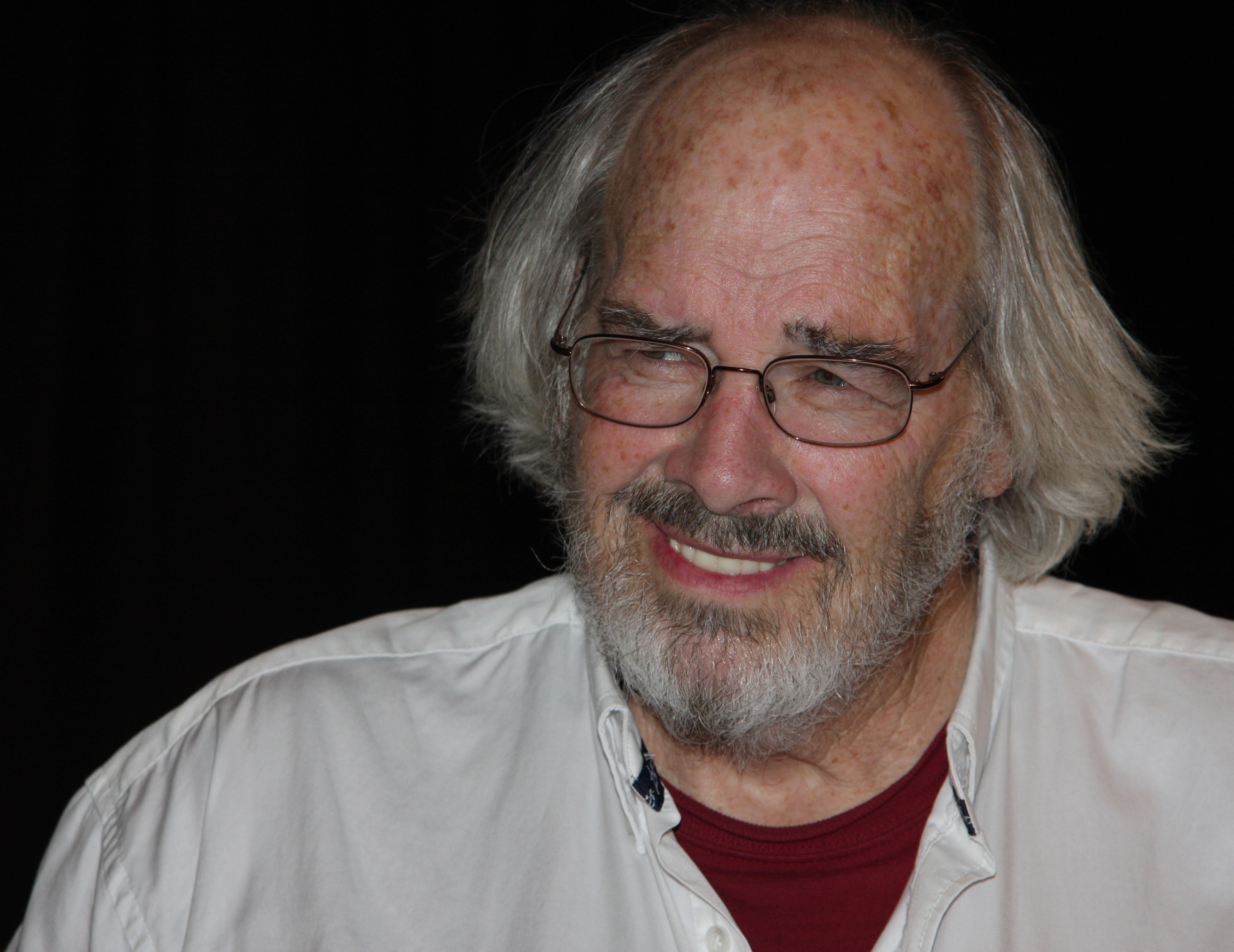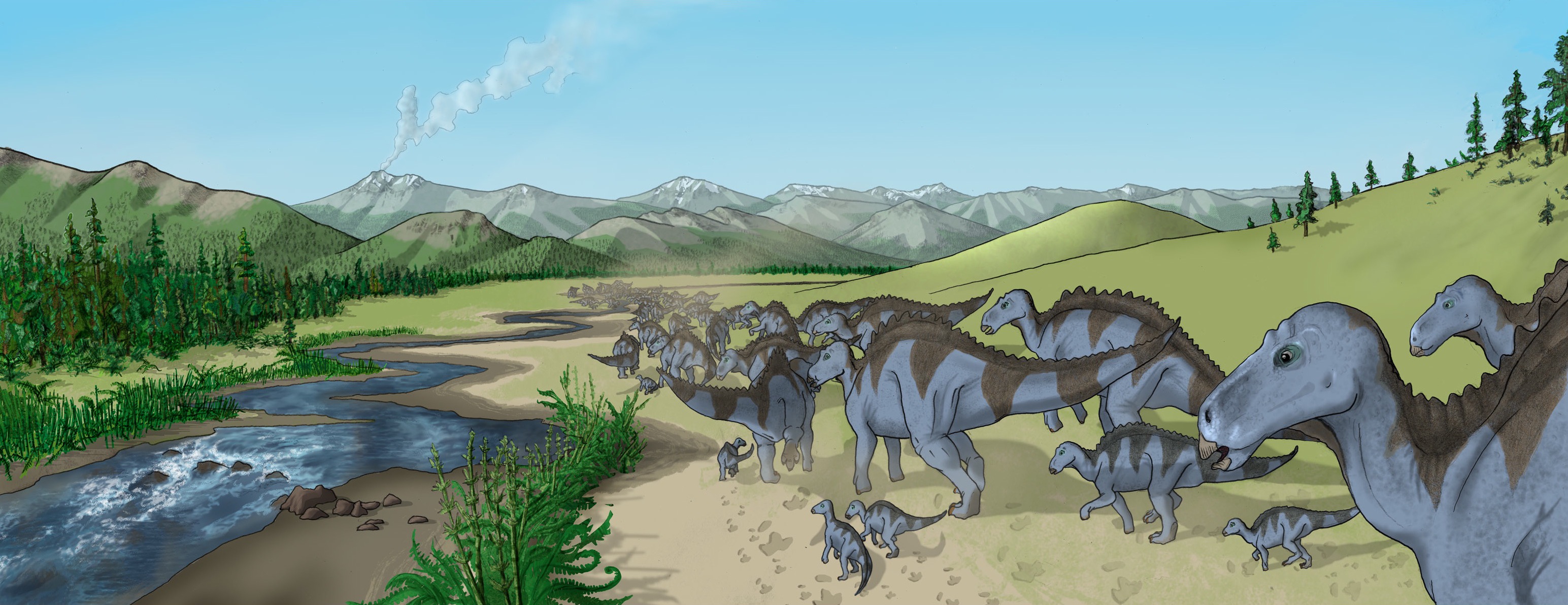|
Achelousaurus
''Achelousaurus'' () is a genus of centrosaurine ceratopsid dinosaur that lived during the Late Cretaceous Period of what is now North America, about 74.2 million years ago. The first fossils of ''Achelousaurus'' were collected in Montana in 1987, by a team led by Jack Horner, with more finds made in 1989. In 1994, ''Achelousaurus horneri'' was described and named by Scott D. Sampson; the generic name means "Achelous lizard", in reference to the Greek deity Achelous, and the specific name refers to Horner. The genus is known from a few specimens consisting mainly of skull material from individuals, ranging from juveniles to adults. A large centrosaurine, ''Achelousaurus'' supposedly was about long, with a weight of about . As a ceratopsian, it walked on all fours, had a short tail and a large head with a hooked beak. It had a bony neck-frill at the rear of the skull, which sported a pair of long spikes, which curved towards the outside. Adult ''Achelousaurus'' had ro ... [...More Info...] [...Related Items...] OR: [Wikipedia] [Google] [Baidu] |
Einiosaurus
''Einiosaurus'' is a genus of herbivorous centrosaurine ceratopsian dinosaur from the Upper Cretaceous (Campanian stage) of northwestern Montana. The name means 'buffalo lizard', in a combination of Blackfeet Indian ''eini'' and Latinized Ancient Greek ''sauros''; the specific name (''procurvicornis'') means 'with a forward-curving horn' in Latin. ''Einiosaurus'' is medium-sized with an estimated body length at . History of discovery The Landslide Butte expeditions ''Einiosaurus'' is an exclusively Montanan dinosaur, and all of its known remains are currently held at the Museum of the Rockies in Bozeman, Montana. At least fifteen individuals of varying ages are represented by three adult skulls and hundreds of other bones from two low-diversity, monospecific (one species) bonebeds, which were discovered by Jack Horner in 1985 and excavated from 1985 to 1989 by Museum of the Rockies field crews. Horner had not been searching for horned dinosaurs. In the spring of 1985 he had bee ... [...More Info...] [...Related Items...] OR: [Wikipedia] [Google] [Baidu] |
Styracosaurus
''Styracosaurus'' ( ; meaning "spiked lizard" from the Ancient Greek / "spike at the butt-end of a spear-shaft" and / "lizard") is a genus of herbivorous ceratopsian dinosaur from the Cretaceous Period (Campanian stage), about 75.5 to 74.5 million years ago. It had four to six long parietal spikes extending from its neck frill, a smaller jugal horn on each of its cheeks, and a single horn protruding from its nose, which may have been up to long and wide. The function or functions of the horns and frills have been debated for many years. ''Styracosaurus'' was a relatively large dinosaur, reaching lengths of and weighing about . It stood about tall. ''Styracosaurus'' possessed four short legs and a bulky body. Its tail was rather short. The skull had a beak and shearing cheek teeth arranged in continuous dental batteries, suggesting that the animal sliced up plants. Like other ceratopsians, this dinosaur may have been a herd animal, travelling in large groups, as sug ... [...More Info...] [...Related Items...] OR: [Wikipedia] [Google] [Baidu] |
Pachyrostra
Pachyrhinosaurini is a tribe of centrosaurine dinosaurs. The clade existed during the Late Cretaceous, about 84.9 to 68.5 million years ago, evolving during the earliest Campanian, and becoming extinct in the Maastrichtian. The tribe contains three genera: ''Einiosaurus'', ''Achelousaurus'', and ''Pachyrhinosaurus''. ''Pachyrhinosaurus'' and ''Achelousaurus'' form the clade of pachyrhinosaurins called the Pachyrostra ("thick-snouts"), characterized primarily by their nasal bosses. Classification Pachyrhinosaurini was defined in 2012 by Fiorillo & Tykoski. It was defined as all centrosaurine ceratopsids more closely related to ''Pachyrhinosaurus canadensis'' than to ''Centrosaurus apertus''. It was defined during the description of ''Pachyrhinosaurus perotorum'', a species from Alaska. The cladogram below represents the findings of Lund et al., 2016, in their description of '' Machairoceratops cronusi''. ''Wendiceratops pinhornensis'', '' Xenoceratops foremostensis'', an ... [...More Info...] [...Related Items...] OR: [Wikipedia] [Google] [Baidu] |
Two Medicine Formation
The Two Medicine Formation is a geological formation, or rock body, in northwestern Montana and southern Alberta that was deposited between and (million years ago), during Campanian (Late Cretaceous) time. It crops out to the east of the Rocky Mountain Overthrust Belt, and the western portion (about thick) of this formation is folded and faulted while the eastern part, which thins out into the Sweetgrass Arch, is mostly undeformed plains. Below the formation are the nearshore (beach and tidal zone) deposits of the Virgelle Sandstone, and above it is the marine Bearpaw Shale. Throughout the Campanian, the Two Medicine Formation was deposited between the western shoreline of the Late Cretaceous Interior Seaway and the eastward advancing margin of the Cordilleran Overthrust Belt. The Two Medicine Formation is mostly sandstone, deposited by rivers and deltas. History of research In 1913, a US Geological Survey crew headed by Eugene Stebinger and a US National Museum crew headed ... [...More Info...] [...Related Items...] OR: [Wikipedia] [Google] [Baidu] |
Pachyrhinosaurus
''Pachyrhinosaurus'' (meaning in Greek "thick-nosed lizard", from ' (), thick; ' (), nose; and (), lizard) is an extinct genus of centrosaurine ceratopsid dinosaur from the Late Cretaceous period of North America. The first examples were discovered by Charles M. Sternberg in Alberta, Canada, in 1946, and named in 1950. Over a dozen partial skulls and a large assortment of other fossils from various species have been found in Alberta and Alaska. A great number were not available for study until the 1980s, resulting in a relatively recent increase of interest in ''Pachyrhinosaurus''. Three species have been identified. ''P. lakustai'', from the Wapiti Formation, the bonebed horizon of which is roughly equivalent age to the upper Bearpaw and lower Horseshoe Canyon Formations, is known to have existed from about 73.5–72.5 million years ago. ''P. canadensis'' is younger, known from the lower Horseshoe Canyon Formation, about 71.5–71 Ma ago and the St. Mary River Formatio ... [...More Info...] [...Related Items...] OR: [Wikipedia] [Google] [Baidu] |
Centrosaurinae
Centrosaurinae (from the Greek, meaning "pointed lizards") is a subfamily of ceratopsid dinosaurs, a group of large quadrupedal ornithischians. Centrosaurine fossil remains are known primarily from the northern region of Laramidia (modern day Alberta, Montana, and Alaska) but isolated taxa have been found in China and Utah as well. Defining features of centrosaurines include a large nasal horn, short supratemporal horns, and an ornamented frill projecting from the back of the skull. With the exception of '' Centrosaurus apertus'', all adult centrosaurines have spike-like ornaments midway up the skull. Morphometric analysis shows that centrosaurines differ from other ceratopsian groups in skull, snout, and frill shapes. There is evidence to suggest that male centrosaurines had an extended period of adolescence, and sexual ornamentation did not appear until adulthood. Centrosaurinae was named by paleontologist Lawrence Lambe in 1915, with '' Centrosaurus'' as the type genus. The ... [...More Info...] [...Related Items...] OR: [Wikipedia] [Google] [Baidu] |
Jack Horner (paleontologist)
John Robert (‘Jack’) Horner (born June 15, 1946) is an American paleontologist most famous for describing ''Maiasaura'', providing the first clear evidence that some dinosaurs cared for their young. In addition to his paleontological discoveries, Horner served as the technical advisor for the first five ''Jurassic Park'' films, had a cameo appearance in ''Jurassic World'', and served as a partial inspiration for one of the lead characters of the franchise, Dr. Alan Grant. Horner studied at the University of Montana, although he did not complete his degree due to undiagnosed dyslexia, and was awarded a Doctorate in Science ''honoris causa''. He retired from Montana State University on July 1, 2016, although he claims to have been pushed out of the Museum of the Rockies after having married an undergraduate student and now teaches as a Presidential Fellow at Chapman University. Biography Horner was born and raised near Shelby, Montana. He was eight years old when he found h ... [...More Info...] [...Related Items...] OR: [Wikipedia] [Google] [Baidu] |
Ceratopsid
Ceratopsidae (sometimes spelled Ceratopidae) is a family of ceratopsian dinosaurs including ''Triceratops'', '' Centrosaurus'', and '' Styracosaurus''. All known species were quadrupedal herbivores from the Upper Cretaceous. All but one species are known from western North America, which formed the island continent of Laramidia during most of the Late Cretaceous. Ceratopsids are characterized by beaks, rows of shearing teeth in the back of the jaw, elaborate nasal horns, and a thin parietal-squamosal shelf that extends back and up into a frill. The group is divided into two subfamilies— Chasmosaurinae and Centrosaurinae. The chasmosaurines are generally characterized by long, triangular frills and well-developed brow horns. The centrosaurines had well-developed nasal horns or nasal bosses, shorter and more rectangular frills, and elaborate spines on the back of the frill. These horns and frills show remarkable variation and are the principal means by which the various species h ... [...More Info...] [...Related Items...] OR: [Wikipedia] [Google] [Baidu] |
Scott Sampson
Scott Donald Sampson (born April 22, 1961) is a Canadian paleontologist and science communicator. Sampson is currently the Executive Director of California Academy of Sciences in San Francisco, California. He was previously Vice President of Research & Collections and Chief Curator at the Denver Museum of Nature & Science,. Sampson is notable for his work on the carnivorous theropod dinosaurs ''Majungasaurus'' and ''Masiakasaurus'' and his extensive research into the Late Cretaceous Period, particularly in Madagascar. He is also known as the presenter of the PBS Kids show ''Dinosaur Train''. Background Sampson was born in the neighborhood of Dunbar-Southlands in Vancouver, British Columbia. He attended Point Grey Secondary School. Sampson studied for a Ph.D. in Zoology from the University of Toronto. For his doctorate he produced a thesis on two newly found species of ceratopsids, dated to the Late Cretaceous period in Montana and the growth and function of ceratopsid horns a ... [...More Info...] [...Related Items...] OR: [Wikipedia] [Google] [Baidu] |
Maiasaura
''Maiasaura'' (from the Greek ''μαῖα'', meaning "good mother" and ''σαύρα'', the feminine form of ''saurus'', meaning "reptile") is a large herbivorous saurolophine hadrosaurid ("duck-billed") dinosaur genus that lived in the area currently covered by the state of Montana and the province of Alberta, Canada in the Upper Cretaceous Period (mid to late Campanian), about 76.7 million years ago.Horner, J. R., Schmitt, J. G., Jackson, F., & Hanna, R. (2001). Bones and rocks of the Upper Cretaceous Two Medicine-Judith River clastic wedge complex, Montana. In Field trip guidebook, Society of Vertebrate Paleontology 61st Annual Meeting: Mesozoic and Cenozoic Paleontology in the Western Plains and Rocky Mountains. Museum of the Rockies Occasional Paper (Vol. 3, pp. 3-14). The first remains of ''Maiasaura'' were discovered in 1978 by Bynum, Montana resident Laurie Trexler. The genus was named in 1979. The name refers to the find of nests with eggs, embryos and young animals, in ... [...More Info...] [...Related Items...] OR: [Wikipedia] [Google] [Baidu] |








